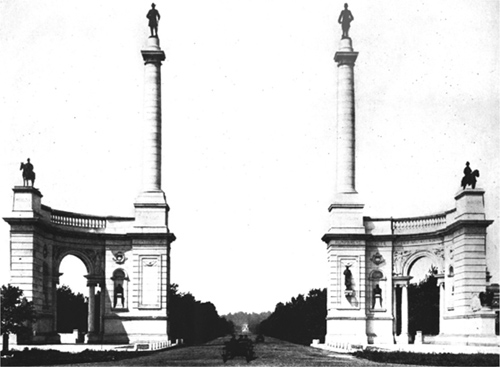
Among the monuments and memorials erected in the city by veterans and citizens to commemorate the honorable service of Philadelphians in the Civil War are the equestrian statue of General John F. Reynolds at the North Plaza of city hall; the equestrian statue of General George B. McClellan at the North Plaza of city hall; the monument of the Artillery Corps, Washington Grays in front of the Union League; the monument of the First Regiment Infantry (Gray Reserves), known as the Spirit of ’61, in front of the Union League; the bronze memorial tablet of the Union League regiments in the main corridor of the Union League House; the monument for the alumni and cadets of Girard College who served during the Civil War on the campus of Girard College; the soldiers and sailors of the Civil War monument on Market Square, Germantown; the monument, Silent Sentinel, for the soldiers’ home (formerly at Mount Moriah Cemetery); the monument for Abraham Lincoln, the Emancipator, along Kelly Drive at Lemon Hill; the equestrian statue of General U.S. Grant on Kelly Drive; the equestrian statue of General George G. Meade behind Memorial Hall, West Fairmount Park; the statue of the soldier of the Civil War (Courtland Saunders Post #21, GAR) near George’s Hill, West Fairmount Park; the Civil War soldiers and sailors memorial pylons monument dedicated to the army and navy near Twentieth Street and Benjamin Franklin Parkway; the Garfield Memorial (president and general in the Civil War) along Kelly Drive, East Fairmount Park; the General Galusha Pennypacker Memorial at Nineteenth Street and Benjamin Franklin Parkway on Logan Circle; the all wars memorial to colored soldiers and sailors on Logan Circle; the Frankford Civil War Monument in Cedar Hill Cemetery; the soldiers monument; Hetty Jones Tomb, Leverington Cemetery; the Scott Legion Monument in Philadelphia National Cemetery; the Civil War memorial tablet to students of the university who fell in the Civil War, University of Pennsylvania; the Corporal Johnny Ring Statue, Corporal Johnny Ring Garden, Mitten Hall, main campus, Temple University; Lincoln the Lawyer, in front of Temple Law School on Broad Street; Captain John Ericsson Fountain (who designed the USS Monitor) on the west side of Eakins Oval in front of the art museum; Clark Park Civil War Memorial (a boulder from Devil’s Den at Gettysburg) on the north side of Clark Park; and the Philadelphia Civil War Memorial, also known as the Smith Memorial, from a bequest of Richard Smith on Centennial Concourse in West Fairmount Park. The military and naval figures featured on this last memorial are the equestrian statue of General Winfield S. Hancock, the equestrian statue of General George B. McClellan, the statue of General Meade, the statue of General Reynolds, and the busts of Admiral David D. Porter, General John F. Hartranft, Admiral Dahlgren, General S. Wylie Crawford, General James A. Beaver and war governor Andrew G. Curtin, executed by Moses Ezekiel, a noted sculptor who had served in the Confederate army. In addition, there are other memorials, plaques and monuments scattered throughout the area, in churches, cemeteries and institutions. Like a treasure hunt of history, the dedicated can seek out these vestiges of the Civil War and ponder their meaning and significance.374
A contemporary lithograph of the principal Philadelphia Civil War Memorial, also known as the Smith Memorial. GAR Museum Collection.
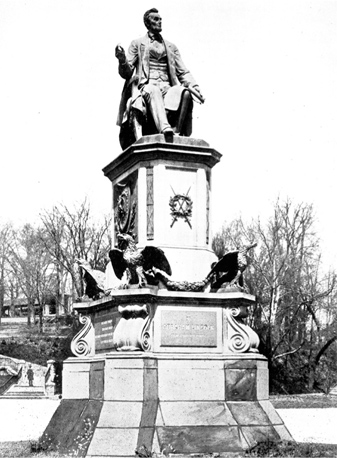
Abraham Lincoln Monument. A lithograph of Lincoln’s the Emancipator monument, dedicated in 1871, one of the first Lincoln memorials in the country. It stands in silent glory along Kelly Drive. GAR Museum Collection.
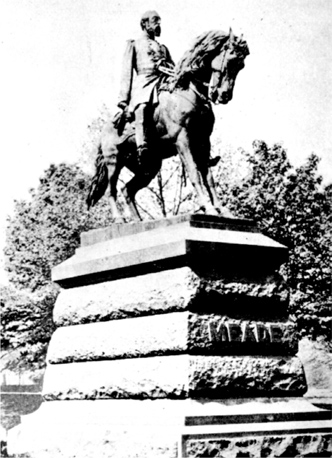
A picture of the notable equestrian monument of General Meade dedicated in 1887 and placed in West Fairmount Park behind Memorial Hall. The sculptor was Alexander M. Calder, and the monument was produced from captured Confederate cannon. GAR Museum Collection.
Dr. Russell Conwell’s grave. Russell Conwell was the founder of Temple University. He was a Union officer in the Civil War and dedicated his life to the ministry and education based on incidents he experienced during the war. Author’s collection.
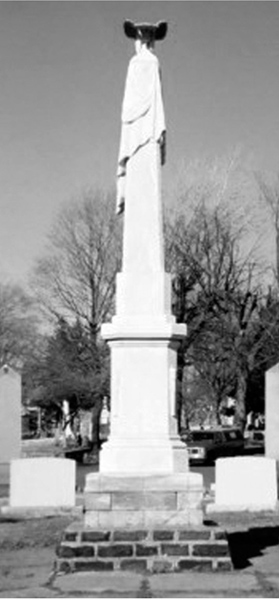
An early Civil War monument erected in Cedar Hill Cemetery in Frankford honoring local veterans who fell during the war. Author’s collection.
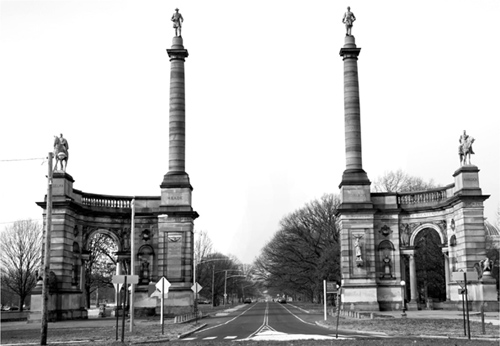
A modern view of the Philadelphia Civil War Memorial—popularly known as the Smith Memorial after its benefactor—located in West Fairmount Park on the Centennial Concourse grounds next to Memorial Hall. Photo by Arlene Harris.
These sites were dedicated to heroes of the war by the Grand Army of the Republic veterans and their posts or were honored by the city. They include the Greble Park, Third Street near Moyamensing Avenue, named in honor of Lieutenant John Greble, 1st U.S. Artillery, who was the first Union officer killed in action in the Civil War; the Birney Park, Sixth Street and Germantown Avenue, named for General David Bell Birney; Thomas J. Powers Park, Ann, Mercer and Almond Streets in Port Richmond, named for a navy veteran and politician; Anna M. Ross Park, Tenth Street and Glenwood Avenue, named for the beloved volunteer nurse; Baker Park, Rising Sun Avenue and York Road, named for General Edward Baker, one of the first major casualties in the war; Reynolds Park, Snyder and Passyunk Avenues and Twenty-third Street, named for General John F. Reynolds, who was killed at Gettysburg; and George C. Platt Memorial Bridge, located over the Schuylkill River, named for an Irish immigrant cavalry trooper who enlisted in the 6th United States Cavalry. He was awarded the Medal of Honor for bravery at the Battle of Fairfield, Pennsylvania, in the Gettysburg Campaign.375
The stately equestrian monument dedicated to General Meade by the citizens of Philadelphia. GAR Museum Collection.